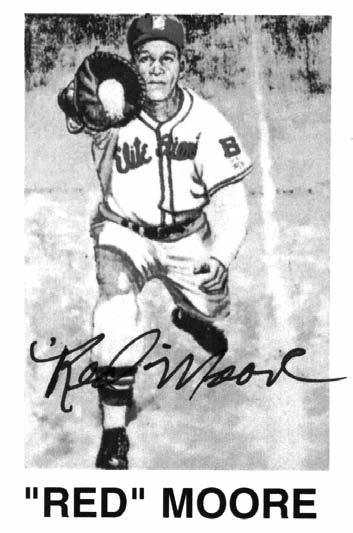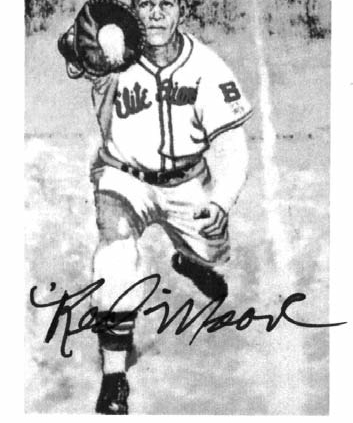Red Moore
 James “Red” Moore had a long and distinguished career in the Negro Leagues, from 1936 to 1948. Best known for his fine fielding, Moore held his own at the plate as well. Playing primarily at first base, Moore anchored the infield for nearly two decades in Atlanta, Baltimore, Indianapolis, and Newark. Born on November 18, 1916, in Atlanta, Moore grew up around the game of baseball. His parents, James and Sadie, supported him playing baseball but also ensured that he attended Booker T. Washington High School. Moore got his start at 13 playing for the local Oakland City Cubs.1 In the 1930 US Census, Sadie Moore was listed as a maid and her husband as a machinist.
James “Red” Moore had a long and distinguished career in the Negro Leagues, from 1936 to 1948. Best known for his fine fielding, Moore held his own at the plate as well. Playing primarily at first base, Moore anchored the infield for nearly two decades in Atlanta, Baltimore, Indianapolis, and Newark. Born on November 18, 1916, in Atlanta, Moore grew up around the game of baseball. His parents, James and Sadie, supported him playing baseball but also ensured that he attended Booker T. Washington High School. Moore got his start at 13 playing for the local Oakland City Cubs.1 In the 1930 US Census, Sadie Moore was listed as a maid and her husband as a machinist.
Moore had to be innovative while he learned to play the game. As a young left-handed first baseman who had no money for a new glove, he turned a right-handed glove inside out and stitched it back together so he could play.2 He and his friends would take old baseballs and tape them back together so they could play. This did not slow him down at all as he played with and against the many semipro teams around the Atlanta area. He finally got his chance at the big leagues when the Newark Eagles signed him after seeing him play with the Macon Peaches and Chattanooga Choo Choos.
The 1936 Newark Eagles that Moore joined included four future Hall of Famers on their roster – Leon Day, Mule Suttles, Willie Wells, and Ray Dandridge. While Red played in only 13 games that first year, he learned a great deal from the team and came back in 1937 to play in 16 games and raise his average to .244. Moore recalled trying to hit against Satchel Paige with Josh Gibson catching. Paige struck out Moore on three straight pitches while Gibson heckled him as a rookie. Moore raised his average to .344 in 1938 with local businessman James Harden’s Atlanta Black Crackers.3 Moore helped the Atlanta club win the second-half pennant in the Negro American League though they lost to Memphis in the abbreviated playoffs. The series was cut short when ball fields could not be secured for all the games. Gabby Kemp managed the club and played second base while “Steel Arm” Eddie Dixon helped lead the pitching staff. Like Moore, most of the team came from the surrounding communities.4
Fans who came out to see Moore play were in for a treat. He became known as a flashy fielder who could make almost any play look easy. He would often make catches one-handed and flip the ball straight from his glove. He could dig out low throws and turn a mean 3-6-3 double play. Moore also warmed up before games by throwing a ball behind his back and through his legs just to entertain the fans. While he played with Atlanta in 1937, Moore’s play was described as “scintillating escapades” and in a game against Chattanooga his fielding saved the game “as his frame sprawled forth on the greensward as he did a backhanded trap on the peg for a miraculous third out.”5 In 1940 a local news reporter referred to him as the “deluxe” first baseman.6 Though Mule Suttles also played first base for the Newark Eagles, Moore was the better fielder, pushing Mule into the outfield when he played. Moore was part of what became known as the “Million Dollar infield” for the 1937 Eagles. He joined established stars Willie Wells, Dick Seay and Ray Dandridge to give the Eagles one of the best defensive clubs in the game.
Moore pioneered another innovation during his early playing days. In addition to his makeshift glove, he started wearing a batting glove to take the sting out of hitting. He took a leather winter glove and cut off the fingertips. He wore it for the rest of his career.7
By 1938 Moore’s popularity in Atlanta was assured. The community thought so much of him that local businesses offered him a new glove, new shoes, a fancy chicken dinner, a new radio, and more. The fans were asked to bring their spare change to drop in the Red Moore pot at the ballpark. All this was happening because fans all over believed Moore to be the best first baseman ever. His own teammates said there was no jealousy over the accolades because “he is … an unusually quiet and likeable chap with a minimum of ‘mouth’ and no lean toward rowdiness.”8 Moore would take this day in stride and not make a big deal out of it. He would just return to playing the game the best way he knew how. When he visited Kansas City to play the Monarchs, fans deemed him the best first baseman they had ever seen. “The way Moore scooped and speared the ball was a feature of every game and he left the fans singing his praises.”9
In 1939 Moore signed with the Baltimore Elite Giants after the Indianapolis/Atlanta team folded, where he found himself rooming with 17-year-old rookie Roy Campanella. Moore and Campanella got along well as they had similar personalities. They were both quiet, unassuming, and well-liked by everyone. Moore and Campanella helped the Giants to a postseason championship series against the Homestead Grays. The Giants beat the Newark Eagles three games to one (with one tie) to make it to the final series. Moore was expected to be one to contribute to the series, even as a newcomer. While most known for his fielding Moore was a good spray hitter who made good contact with the ball. He hit .214 in the five-game series with three hits and two walks.10
By mid-June of 1940, the city of Atlanta was looking to bring back the Black Crackers. One reporter said the only thing the team needed to ensure success was to bring back fan favorite Red Moore. The new owner, Mr. Greer, was told, “[S]ecure at whatever the cost the services of ‘Red Moore,’ Atlanta idol to play ball here. … Baseball will pay in Atlanta, but if you want it resurrected and a moneymaker at the start make steps to secure Red Moore.”11
After the 1940 season with Baltimore, Moore was in high demand. Double Duty Radcliffe tried to secure his services for Memphis while Syd Pollock also wanted Moore for the Ethiopian Clowns. Instead, Moore ended up being traded to the New York Black Yankees.12
Moore lost three years of playing time during World War II. He entered the US Army as a combat engineer in 1942, serving in England, Belgium, and France. After the war ended, Moore returned to play for the Atlanta Black Crackers for three more years, ending his career after the 1948 season. Moore then went to work for Colonial Warehouse in Atlanta, living in the area with his wife, Mary. He worked until his retirement in 1981. It would be many more years before Moore’s accomplishments started to be remembered and recognized. The Georgia House of Representatives honored him with a resolution, and the local Mike Glenn Foundation presented him with a Pioneer Award. In 2006 his baseball achievements were further honored with his election to the Atlanta Sports Hall of Fame.13
In 2008 Major League Baseball held a special draft and Moore was selected by the Atlanta Braves. Moore had been a three-time all-star, played on championship teams, and was beloved by the fans. Moore died at the age of 99 on February 6, 2016. Services were held at Missionary Baptist Church, where Moore had served as a deacon. Moore loved the game of baseball and was lucky enough to live long enough to enjoy his many honors and accolades. Moore told a reporter, “It makes me feel real big to be honored. People can see history and not just read about it. That makes me feel real big.”14
Sources
In addition to the sources cited in the Notes, the author consulted Seamheads and the National Baseball Hall of Fame player files.
Notes
1 Oral history interview with James “Red” Moore, October 15, 1978. Living Atlanta oral history collection, Digital Library of Georgia; https://ohms.libs.uga.edu/viewer.php?cachefile=dlg/livatl/ahc-637-105-001.xml. Accessed February 5, 2024.
2 James A. Riley, “He Could Pick It,” 2010 National Pastime: Baseball in the Peach State, https://sabr.org/journal/article/red-moore-he-could-pick-it/.
3 Red Moore. https://www.baseball-reference.com/players/m/moorere01.shtml.
4 James “Red” Moore interview, October 15, 1978.
5 Ric Roberts, “Red Moore, Tiloshi Howard Make Good in League,” Atlanta Daily World, April 4, 1937: 7.
6 Lucius Jones, “Atlanta Fans Await Baseball Opener This Week,” Atlanta Daily World, March 25, 1940: 5.
7 Riley, “He Could Pick It.”
8 Ric Roberts, “Trammell Scott, Sou. League President, Honors Red Moore,” Atlanta Daily World, July 22, 1938: 5; “Black Crackers Arrive Tonight,” Atlanta Daily World, July 23, 1938: 5.
9 “Kansas City Fans Call Red Moore ‘The Greatest to Ever Visit Kansas City,’” Atlanta Daily World, June 8, 1938: 5.
10 “Elites to Play Grays for Championship,” Baltimore Afro-American, September 16, 1939: 23; https://www.baseball-reference.com/postseason/1939_NLC.shtml.
11 I.P. Reynolds, “‘Red’ Moore Still Lingers in Our Memory,” Atlanta Daily World, June 21, 1940: 5.
12 Melancholy Jones, “Sports Slants,” Atlanta Daily World, April 13 and 27, 1941: 8; “James (Red) Moore, Baltimore First Baseman, Traded to New York Outfit,” Atlanta Daily World, April 12, 1941: 5.
13 James A. Riley, “He Could Pick It.”
14 James “Red” Moore obituary, Atlanta Journal Constitution, February 7-12, 2016; Adena Andrews, Negro Leagues First Baseman James ‘Red’ Moore Still Living the Dream – ESPN, February 25, 2011.
Full Name
James Robert Moore
Born
November 18, 1916 at Atlanta, GA (USA)
Died
February 6, 2016 at Atlanta, GA (USA)
If you can help us improve this player’s biography, contact us.


